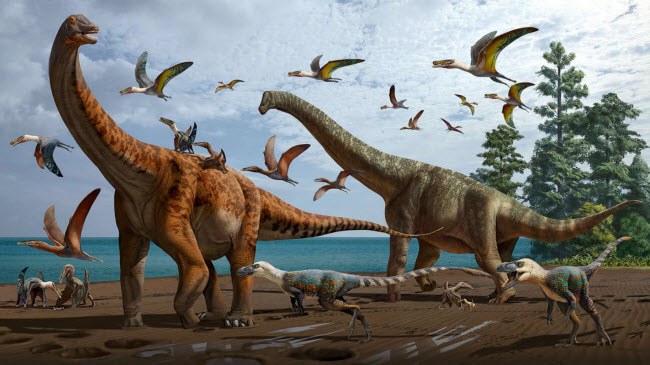Dinosaurs were a group of reptiles believed to have been warm-blooded, appearing on our planet during the Triassic period, around 240 million years ago. They dominated the world until the end of the Cretaceous period, about 66 million years ago, when they abruptly went extinct, a phenomenon that has baffled scientists. The prevailing theory is that a giant asteroid collision with Earth was the primary cause. During their reign, dinosaurs evolved from mostly dog- and horse-sized creatures into the largest beasts ever to roam the Earth. Additionally, another lineage evolved into birds. The term “dinosaur” comes from the Greek words “deinos,” meaning terrible or fearsome, and “sauros,” meaning lizard, thus “terrible lizard.”
When dinosaurs first appeared, they had a unique anatomy that distinguished them from other animals. They belonged to the group “Archosauria,” which also includes crocodiles, pterosaurs, and dinosaurs themselves. Archosaurs emerged around 252 million years ago. Over time, some, including dinosaurs, evolved a more upright posture with legs positioned directly under their bodies, as opposed to extending outwards. This upright stance allowed for the development of limbs that could grasp branches, as seen in “Iguanodon,” or develop claws for capturing and killing prey, as in the case of carnivorous dinosaurs. This free arm movement also enabled some species that evolved into birds to glide and eventually fly. The oldest dinosaur fossils, found in the Ischigualasto Provincial Park in northwestern Argentina, date back to approximately 231 million years.
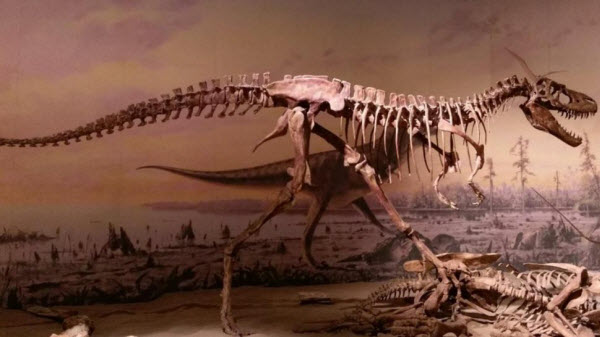
Dinosaur Types
As of 2021, there are 1,545 scientifically described dinosaur species according to paleobiological databases. Each year, about 50 new species are described, indicating that a new species is discovered almost weekly. These species fall into three main categories:
- Ornithischia: This group includes plant-eaters with beaks, like “Stegosaurus” and duck-billed dinosaurs such as “Hadrosaurus,” as well as horned dinosaurs like “Triceratops” and armored dinosaurs like “Ankylosaurus.” Some walked on four legs, while others walked on two.
- Sauropodomorpha: These dinosaurs were characterized by their long necks, small heads, and column-like limbs. They include sauropods like “Diplodocus,” smaller ancestors such as “Plateosaurus,” and very large sauropods like “Dreadnoughtus” and “Argentinosaurus,” which are among the largest land animals ever known.
- Theropoda: This category consists of mostly carnivorous dinosaurs, though some, like “Chilesaurus,” were omnivorous. It includes famous theropods like “Tyrannosaurus rex” and “Velociraptor,” as well as birds that evolved from small-footed theropods.
Historically, it was believed that the bird-like Theropoda and Sauropodomorpha were closely related, but a 2017 study in Nature challenged this by suggesting that Ornithischia and Theropoda were more closely related based on an analysis of 74 dinosaur species.
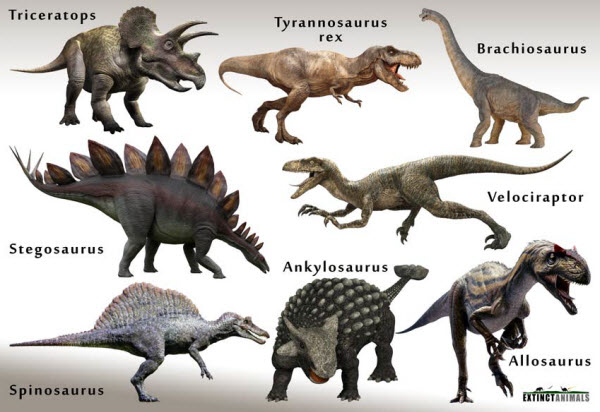
When Did Dinosaurs Live?
Dinosaurs thrived during most of the Mesozoic Era, which lasted from 252 to 66 million years ago. This era included the Triassic, Jurassic, and Cretaceous periods. Dinosaurs emerged from smaller ancestors during the Triassic, a time of harsh and dry climate, and faced competition from archosaurs like crocodiles for millions of years. They eventually became dominant due to volcanic eruptions along the supercontinent’s rifts, which led to global warming and the extinction of archosaurs.
During the Jurassic period (201.3 to 145 million years ago), dinosaurs became the dominant terrestrial animals, with some growing to enormous sizes. For example, “Foyveria dambensis,” considered the oldest titanosaur, lived 160 million years ago, weighed about 15 tons, and was 15 meters long. Famous dinosaurs from this period include “Brontosaurus,” “Brachiosaurus,” and “Stegosaurus.” This period also saw the evolution of flowering plants and the first birds, such as “Archaeopteryx.”
In the Cretaceous period, dinosaurs continued to dominate with well-known species like “Tyrannosaurus rex,” “Triceratops,” and “Spinosaurus.” Some of the largest dinosaurs, such as “Argentinosaurus,” also lived during this time. The Cretaceous ended with a catastrophic asteroid impact, creating a crater more than 180 km wide in the Yucatán Peninsula of Mexico, leading to the extinction of dinosaurs.
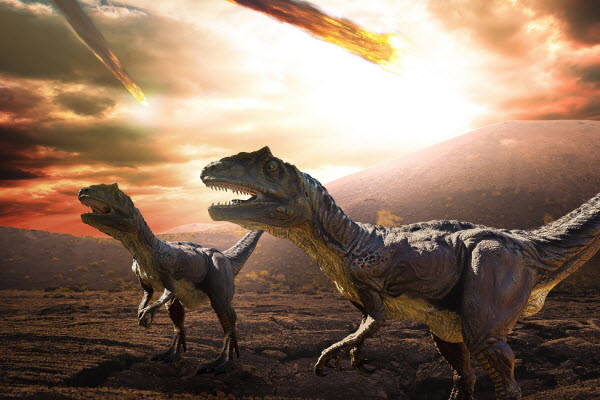
Largest and Smallest Species
Some dinosaurs were colossal, while others were tiny. The smallest recorded dinosaur is the living bee hummingbird from Cuba, measuring over 5 cm in length and weighing less than 2 grams. Among extinct non-avian dinosaurs, contenders for the smallest include the bat-like “Microraptor” from China, measuring 32 cm in length and weighing about 306 grams, according to a 2019 study in Nature.
The largest dinosaurs include “Titanosaurus.” Since complete skeletons are rare and soft tissues like organs and muscles rarely fossilize, determining their mass is challenging. However, contenders for the title of the largest dinosaur include “Argentinosaurus,” weighing up to 100 tons, an unnamed 98-million-year-old dinosaur from Argentina, weighing 63 tons, and “Patagotitan,” weighing 96 tons. The longest dinosaur might be “Supersaurus,” a Jurassic sauropod measuring at least 39 meters, possibly up to 42 meters, according to unpublished research presented at the 2021 Vertebrate Paleontology conference. Another long dinosaur is “Diplodocus,” which could reach 33 meters in length according to a 2006 study. A slightly smaller long dinosaur is “Giraffatitan,” measuring 12 meters and dating from the late Jurassic, around 150 million years ago, from Tanzania.
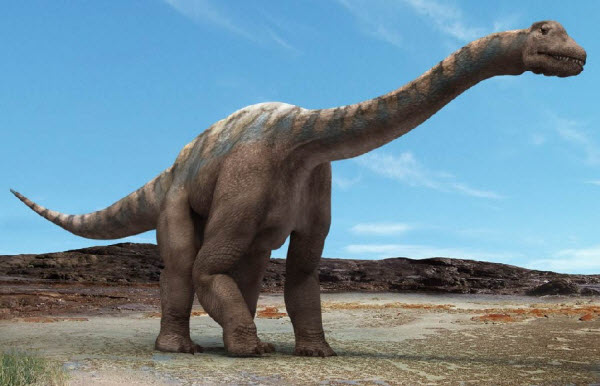
Non-Dinosaurian Species
Many remarkable animals lived during the age of dinosaurs but were not dinosaurs themselves. Common misconceptions include “pterosaurs,” winged reptiles mistaken for dinosaurs, though they belong to the Archosaur group. Also included are extinct and living crocodiles. The Mesozoic oceans teemed with marine reptiles like “Mosasaurus,” “Plesiosaurs,” and “Ichthyosaurs,” but none of these were dinosaurs.
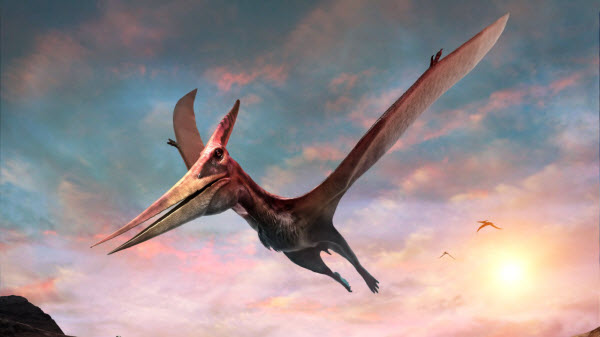
Did Dinosaurs Have Feathers?
Dinosaurs did have feathers, similar to birds. Although feathers do not fossilize well, some fossils, particularly those from the Liaoning Province in China, which were buried after volcanic eruptions, have preserved feathers. It is unclear why feathers first evolved in dinosaurs, but they may have been used for insulation, display, or flight. Initially, it was thought that only theropods and their descendants had feathers, but researchers have also found feathers on some herbivorous dinosaurs, suggesting that feathers were more widespread than previously believed.
Interestingly, while “Tyrannosaurus rex” likely had feathers, popular culture, including films like “Jurassic Park,” often depicts dinosaurs without feathers. Paleontologist Jack Horner, who advised on the films, suggested to director Steven Spielberg that dinosaurs should have feathers, but this was not adopted due to technical challenges and Spielberg’s preference for a more fearsome appearance.
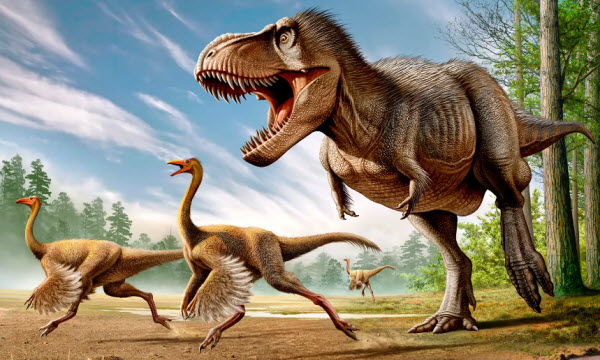
Could Dinosaurs Fly?
Some dinosaurs could fly, including the oldest known bird, “Archaeopteryx,” discovered in Germany and dating back about 150 million years. Unlike most modern birds, extinct dinosaurs probably flew short distances. Research indicates that strong leg muscles, large wings, and relatively small body sizes were necessary for flight in ancient birds and bird-like dinosaurs. The bat-like “Yi qi,” from the Jurassic period, had wings according to a 2015 study in Nature.
Why Did Dinosaurs Go Extinct?
Several studies suggest that dinosaur extinctions increased toward the end of the Cretaceous period, with a decrease in diversity, especially among herbivorous dinosaurs. However, these studies rely on incomplete fossil records and models that may not fully capture the picture. Most scientists agree that the primary cause of extinction was the asteroid impact. Without this catastrophic event, dinosaurs might have continued to thrive and diversify today.
Following the asteroid impact, the ensuing chaos caused massive destruction, including intense shock waves, forest fires, tsunamis, volcanic eruptions, acid rain, and earthquakes. The dust and debris in the atmosphere raised global temperatures for hours, incinerating larger animals that could not find shelter. Smaller animals that could hide underground, underwater, or in caves or large tree trunks might have survived the initial thermal blast.
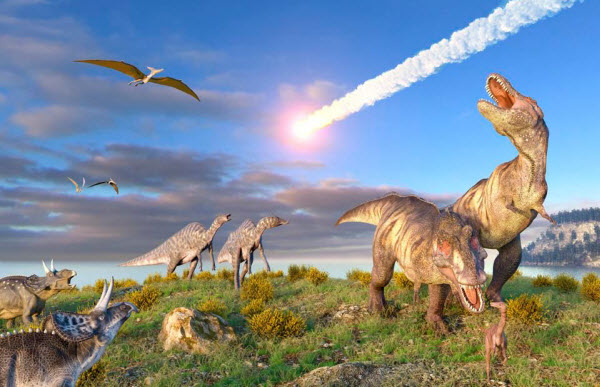
Subsequent atmospheric particles blocked sunlight for several years, causing a “nuclear winter” that cooled the planet’s surface and led to the extinction of countless plants and animals. Small predatory animals like mammals, lizards, turtles, and birds survived by scavenging dinosaur carcasses, fungi, roots, and decaying plant matter. The asteroid also crushed carbon-rich rocks, releasing carbon dioxide into the atmosphere and causing a brief period of global warming.
Some scientists also suggest that volcanic eruptions in what is now India contributed to the extinction, but recent studies show that their impact was minimal compared to the asteroid impact.
Is It Possible to Bring Dinosaurs Back?
In the popular film series “Jurassic Park,” scientists find dinosaur DNA preserved in ancient amber and fill gaps with frog DNA. While this makes for an entertaining story, it is far from scientific reality. Amber does not preserve DNA well, and frogs are not closely related to dinosaurs. A 2017 study found that frog evolution began after the asteroid impact.
For numerous reasons, resurrecting extinct dinosaurs is currently impossible. Although dinosaur proteins and blood vessels have been found, scientists have not yet accurately identified dinosaur DNA. DNA degrades immediately after an organism’s death, though it can be preserved under certain conditions. The oldest recorded DNA sequence belongs to a mammoth, about one million years old, far younger than the 66 million years since dinosaurs went extinct.
Currently, some scientists are exploring how to reverse-engineer birds into dinosaurs, including creating “dino-chickens” with long tails, teeth, and arms with fingers. However, researchers stress that such creations would not be true replicas of ancient dinosaurs but birds resembling them.
